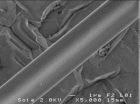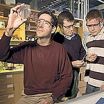(Press-News.org) University of Luxembourg's Laboratory for Photovoltaics has established a method to observe and prevent solar cell degradation before solar cell production is finished, which has implications for the solar cell manufacturing industry since chemical damage to solar cells can occur quickly.
Solar panels are capable of converting light energy from the sun into electrical energy because they contain solar cells – the "power generators" responsible for the energy in solar panels. Thin film solar cells have a coating that is responsible for absorbing the sun's energy, but this film can be degraded during the production process.
"A thin film solar cell is a stack of several layers. The main one is the layer that absorbs the light and transforms it into electricity. If these absorbers are not processed immediately they lose part of their ability to convert light energy," says researcher David Regesch of the Laboratory for Photovoltaics, Physics Research Unit at the University of Luxembourg.
Researchers measured the light that is released by a solar cell when a laser is shone on it, and found that the degradation happens within the first few minutes. They also found that the degradation is reversible and prevented by quickly placing another layer on the solar cell. This makes the solar cell stable.
In the photovoltaics industry, solar cells are processed as fast as possible for economic reasons, and now scientists have shown a physical reason why this process should be completed quickly. This study was recently published in Applied Physical Letters and chosen as a research highlight.
###New publication: Regesch, D. et al. Degradation and passivation of CuInSe2. Appl. Phys. Lett. 101, 112108 (2012) . http://apl.aip.org/resource/1/applab/v101/i11/p112108_s1?bypassSSO=1
For more information please visit www.uni.lu/research.
Research findings in solar cells will have an impact on solar panel industry
New findings in solar cell research
2012-10-11
ELSE PRESS RELEASES FROM THIS DATE:
DNA confirms genetically distinct lion population for Ethiopia
2012-10-11
A team of international researchers has provided the first comprehensive DNA evidence that the Addis Ababa lion in Ethiopia is genetically unique and is urging immediate conservation action to preserve this vulnerable lion population.
While it has long been noted that some lions in Ethiopia have a large, dark mane, extending from the head, neck and chest to the belly, as well as being smaller and more compact than other lions, it was not known until now if these lions represent a genetically distinct population.
The team of researchers, led by the University of York, ...
A gene implicated in schizophrenia risk is also associated with risk for cannabis dependence
2012-10-11
Philadelphia, PA, October 11, 2012 – A paper by Shizhong Han and colleagues in the current issue of Biological Psychiatry implicates a new gene in the risk for cannabis dependence. This gene, NRG1, codes for the ErbB4 receptor, a protein implicated in synaptic development and function.
The researchers set out to investigate susceptibility genes for cannabis dependence, as research has already shown that it has a strong genetic component.
To do this, they employed a multi-stage design using genetic data from African American and European American families. In the first ...
Researchers create 'nanoflowers' for energy storage, solar cells
2012-10-11
Researchers from North Carolina State University have created flower-like structures out of germanium sulfide (GeS) – a semiconductor material – that have extremely thin petals with an enormous surface area. The GeS flower holds promise for next-generation energy storage devices and solar cells.
"Creating these GeS nanoflowers is exciting because it gives us a huge surface area in a small amount of space," says Dr. Linyou Cao, an assistant professor of materials science and engineering at NC State and co-author of a paper on the research. "This could significantly increase ...
Eco-friendly optics: Spider silk's talents harnessed for use in biosensors, lasers, microchips
2012-10-11
WASHINGTON, Oct. 11—Spiders use their silk to catch lunch. Now physicists are using it to catch light. New research shows that natural silk could be an eco-friendly alternative to more traditional ways of manipulating light, such as through glass or plastic fiber optic cables. Two teams independently exploring possible applications for the material's photonic talents will present their latest breakthroughs at the Optical Society's (OSA) Annual Meeting, Frontiers in Optics (FiO) 2012, to be held next week in Rochester, N.Y.
Biomedical engineer Fiorenzo Omenetto of Tufts ...
Airborne superbugs elude hospital cleaning regimes
2012-10-11
Hospital superbugs can float on air currents and contaminate surfaces far from infected patients' beds, according to University of Leeds researchers.
The results of the study, which was funded by the Engineering and Physical Sciences Research Council (EPSRC), may explain why, despite strict cleaning regimes and hygiene controls, some hospitals still struggle to prevent bacteria moving from patient to patient.
It is already recognised that hospital superbugs, such as MRSA and C-difficile, can be spread through contact. Patients, visitors or even hospital staff can inadvertently ...
India's public school students on par with private students
2012-10-11
EAST LANSING, Mich. — Contrary to past research, private school students in India do not outperform their counterparts in public schools, finds a new study by a Michigan State University education researcher.
The study challenges the claim that private schools are superior – a hot issue in India and other developing countries that are expanding K-12 educational offerings. During the past decade, some 40 million children have entered India's education system, giving rise to a growth in privately run schools.
"Our study finds no consistent benefit of attending a private ...
UMass Amherst research scores advance in manipulating T-cells
2012-10-11
AMHERST, Mass. – Until recently, medical researchers had little hope of experimentally manipulating naïve T cells to study their crucial roles in immune function, because they were largely impenetrable, says polymer scientist Gregory Tew: "So far off limits we could not readily get inside to investigate their workings."
Now, he and colleagues including immunologist Lisa Minter have found a way not only to get inside naïve T cells, but to deliver bio-active cargo such as proteins and synthetic molecules across that long-locked cell membrane, by using a new synthetic protein ...
New report examines potential impact of changes in Texas' Women's Health Program
2012-10-11
WASHINGTON and NEW YORK – A new report finds that Texas policies to exclude Planned Parenthood clinics from a state family planning program – the Women's Health Program (WHP) – would result in leaving tens of thousands of women unable to get care.
"Deteriorating Access to Women's Health Services in Texas: Potential Effects of the Women's Health Program Affiliate Rule," released by the Geiger Gibson/RCHN Community Health Foundation Research Collaborative in the Department of Health Policy of the George Washington University School of Public Health and Health Services, ...
Nerve signal discovery backs Nobel winner's theory
2012-10-11
Scientists have proved a 60-year-old theory about how nerve signals are sent around the body at varying speeds as electrical impulses.
Researchers tested how these signals are transmitted through nerve fibres, which enables us to move and recognise sensations such as touch and smell.
The findings from the University of Edinburgh have validated an idea first proposed by Nobel laureate Sir Andrew Huxley.
It has been known for many years that an insulating layer – known as myelin – which surrounds nerve fibres is crucial in determining how quickly these signals are ...
Arctic and Southern Oceans appear to determine the composition of microbial populations
2012-10-11
Differing contributions of freshwater from glaciers and streams to the Arctic and Southern oceans appear to be responsible for the fact that the majority of microbial communities that thrive near the surface at the Poles share few common members, according to an international team of researchers, some of whom were supported by the National Science Foundation (NSF).
In a paper published in the Oct. 8 edition of the Proceedings of the National Academy of Sciences (PNAS), the researchers report that only 25 percent of the taxonomic groups identified by genetic sequencing ...
LAST 30 PRESS RELEASES:
Making lighter work of calculating fluid and heat flow
Normalizing blood sugar can halve heart attack risk
Lowering blood sugar cuts heart attack risk in people with prediabetes
Study links genetic variants to risk of blinding eye disease in premature infants
Non-opioid ‘pain sponge’ therapy halts cartilage degeneration and relieves chronic pain
AI can pick up cultural values by mimicking how kids learn
China’s ecological redlines offer fast track to 30 x 30 global conservation goal
Invisible indoor threats: emerging household contaminants and their growing risks to human health
Adding antibody treatment to chemo boosts outcomes for children with rare cancer
Germline pathogenic variants among women without a history of breast cancer
Tanning beds triple melanoma risk, potentially causing broad DNA damage
Unique bond identified as key to viral infection speed
Indoor tanning makes youthful skin much older on a genetic level
Mouse model sheds new light on the causes and potential solutions to human GI problems linked to muscular dystrophy
The Journal of Nuclear Medicine ahead-of-print tip sheet: December 12, 2025
Smarter tools for peering into the microscopic world
Applications open for funding to conduct research in the Kinsey Institute archives
Global measure underestimates the severity of food insecurity
Child survivors of critical illness are missing out on timely follow up care
Risk-based vs annual breast cancer screening / the WISDOM randomized clinical trial
University of Toronto launches Electric Vehicle Innovation Ontario to accelerate advanced EV technologies and build Canada’s innovation advantage
Early relapse predicts poor outcomes in aggressive blood cancer
American College of Lifestyle Medicine applauds two CMS models aligned with lifestyle medicine practice and reimbursement
Clinical trial finds cannabis use not a barrier to quitting nicotine vaping
Supplemental nutrition assistance program policies and food insecurity
Switching immune cells to “night mode” could limit damage after a heart attack, study suggests
URI-based Global RIghts Project report spotlights continued troubling trends in worldwide inhumane treatment
Neutrophils are less aggressive at night, explaining why nighttime heart attacks cause less damage than daytime events
Menopausal hormone therapy may not pose breast cancer risk for women with BRCA mutations
Mobile health tool may improve quality of life for adolescent and young adult breast cancer survivors
[Press-News.org] Research findings in solar cells will have an impact on solar panel industryNew findings in solar cell research




